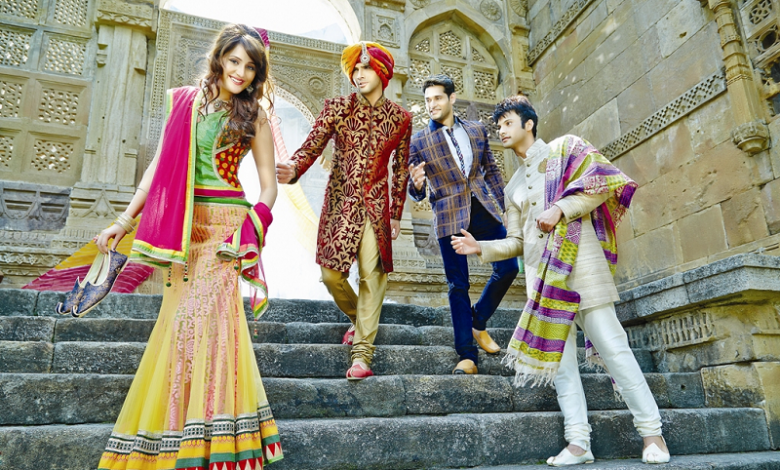5 Traditional Indian Clothing for Men & Women

The never-ending stories of Indian ethnic wear entice all. Even Traditional Indian clothing and indigenous art have got immense admiration from UNESCO and other international organizations. There is no doubt that Indian ethnic wear has the most versatile and diverse designs and styles to flaunt. The unique craftsmanship shown by the local artisans has been passed from one generation to the other in these ethnic dresses. Over the years, the ethnic dresses have witnessed a lot of transformation but the basics have remained the same. In fact, the textile ministry of India is also taking major steps to preserve the age-old traditional arts and preparing a platform to showcase them to the entire world.
Different Types of Indian Ethnic Clothing
The traditional clothing choices have evolved since ages. The rich history of India is responsible for such transformations and the evolution of ethnic wear. The Gupta Period, Mughal rule, and the era of British colonization brought a drastic change and diversity in Indian clothing. Later in the 1980s, the exposure to global culture, the Indian market started adopting western wear more than ethnic apparel. For this, fusion apparels and new concepts boomed and gave a new twist to the ethnic world. Here are a few of the ethnic wear prevalent in the entire subcontinent.
- Saree
Sarees are and always will be the most popular choice for us. It was hard for the westerners to believe that a single piece of long cloth can be worn in such a fashionable way. Every part of India has its own signature saree designs. Its span varies from 15 feet to 27 feet in length and 2 to 4 feet in width. The long piece of ethnic clothing is wrapped around the waist and then hung over a shoulder as a drape. It dates back to Indus Valley Civilization. An estimation of 75% of the entire women population in India wears saree every day. Saree is worn with a blouse. In most of the designs, a saree comes with a blouse piece for a matching fit.
- Lehenga
Rajasthan and Gujarat are considered to be the birthplace of this beautiful ethnic wear. Lehenga and choli are the most popular choices for party wear. This attire is available in different designs. A lehenga is a traditional long skirt with a big perimeter at the bottom. The flailing lehenga is paired with a choli as the upper part of the ensemble. It has been found that the designs have been widely borrowed from the Moghul tradition. The intricate designs consist of heavy embroidery and exquisite sequin features. The monochromatic lehengas with simple designs are also an all-time favorite. In this category, bright and beautiful colors are chosen according to the occasions.
- Salwar Suits
Hailing from Kashmir and Punjab, salwar suits have become a part and parcel of Indian women’s everyday ensemble. It is a comfortable and easily-manageable ensemble for daily use. It consists of a suit or churidar as the upper part and a salwar as the lower part. The salwar resembles a trouser or a pajama. The salwar is generally prepared as a skin-fit lower wear. The various combinations offer different kinds of salwar and kameez combinations. This ethnic wear is very popular in the entire subcontinent due to its versatility and textures.
- Sherwani
Sherwani resembles knee-length upper wear closely related to a jacket. The medieval era witnessed this couture worn by the nawabs and maharajas. It evolved with time and became a part and parcel of Indian weddings. It is also known as Achkans. This ethnic apparel has strings to tie the front or side opening. It is worn with churidar or dhotis. The designs have got a major makeover with embellishments and embroidery work. This is the perfect ensemble fabricated for special occasions and festive celebrations for men.
- Dhoti
Dhoti is one of the oldest ensembles for men. It was a staple lower wear for men since ages. After western attire overtook the Indian markets, dhoti became ethnic wear for special occasions and celebrations. The styles of wearing a dhoti vary from one state to the other. The latest trends in wearing dhoti with jackets and sherwanis are catching up quickly with the contemporary population. The fabric used to make dhotis is mainly cotton. These days, there are excellent choices to adore. By including traditional art and designs, dhotis are a brilliant choice for men to wear in different ways. From Kerala to West Bengal, Gujarat to Uttar Pradesh, dhoti represents manliness in its own way.
Verdict
There are many other types of Traditional Indian clothing that has caught the attention of the entire world. Ethnic apparels have their characteristics and usefulness. It has been developed and used for centuries. Despite the westernization and globalization of the Indian clothing industry, these ensembles are and always will be the favorite choices for festivals and celebrations.
